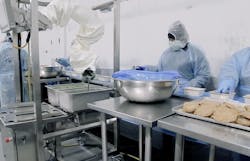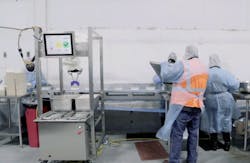AI-Enabled Robotic System Targets High-Mix Food Manufacturing
Chef Robotics first appeared on Automation World’s radar as a developer of robotic systems for meal preparation in restaurants. Though the restaurant industry is outside our coverage area of industrial manufacturing, we thought it was an interesting application for robotics worth watching. Recently, our interest in Chef Robotics was piqued again when we learned that the company was broadening the target markets for its robotic system to include industrial food production kitchens.
Rajat Bhageria, founder and CEO of Chef Robotics, explained the company’s expansion of focus. “The fact is that most commercial kitchens are restaurants and ghost kitchens. What we realized working directly with casual kitchens is that they have quite a few ingredients, but the volume is low. After all, most restaurants are not making millions of meals a day. What's beautiful about food manufacturing is that the jobs are more specialized. The person on the line doing assembly—or plating—is not doing the cooking and the person cooking is not doing prep work. These are specialized jobs in food manufacturing. So our goal of creating a system that can do assembly really well would work well for food manufacturers and we’ve found a good reception from that market.”
Given the realities of food manufacturing operations, Bhageria says Chef Robotics’ idea is not (at least for now) to automate an entire food production line, but to enable food manufacturers to insert a couple of robots on, say, a six-station assembly line to optimize food assembly operations.
Explaining Chef Robotics approach to high-mix food manufacturing, Bhageria explains that this industry has historically been difficult to automate because of the numerus SKUs and line changeovers. For example, running 3,000 trays of jambalaya rice and then 8,000 trays of bean stew mix on the same line. “A manufacturer may do changeovers like this up to twenty times per day,” he says.
“Manufacturers have tried using traditional automation including multi-head dispensers, vertical form fillers, weigh scales, vibratory feeds and augers,” Bhageria says. “But the variability of each ingredient and the large amount of time needed to clean a depositor between runs means that manufacturers need the flexibility of people.”
The difficulties with relying on so much human labor in this industry are: the amount of labor required to meet demand, repetitive motions necessary in production that can lead to injury, and the fact that many food manufacturing environments are cold room environments, with temperatures held just above freezing.
“This means that hiring and retaining labor is an ongoing challenge for food manufacturers,” says Bhageria. “And that results in manufacturers running severely under-capacity, which is often their main pain point.”
To address these issues, Chef Robotics developed its AI-enabled robotic Chef. Unlike traditional robotic depositors, Chef mimics the flexibility of human pick-and-place motions by using AI (artificial intelligence) to sense where in a pan of food to pick from as well as locating food trays on a conveyor and where to place food in them. This AI technology, alongside interchangeable utensils, allows Chef to be as flexible as a human, according to Bhageria.
“Chef can pick the vast majority of scoopable ingredients a human can, be as consistent as a person, work with any portion size, place components anywhere on the tray in a precise manner, work with almost all trays and work with almost all conveyors,” he says.
How Chef works
To create its Chef system, Chef Robotics uses off-the-shelf hardware. Bhageria says, with this approach, Chef Robotics works much like a system integrator. The difference is that, instead of being a hardware-driven company like many integrators, Chef Robotics is an AI and software-driven company.
“Our system is an articulated cobot arm, a couple of RGBD cameras (which provide depth and color capabilities), two trays with electrical components and a dashboard (HMI). It's a very simple system,” he says. “We are making an AI system that allows us to take commoditized hardware and make it flexible. By flexible I mean that the same system can go from handling rice to handling a sauce or chili the same day with each of these ingredients being of different portion sizes and being placed into different compartments or even different types of trays.”
Chef is flexible from a conveyor perspective, as well. “We don't need a physical wire, code or any other direct connection to the conveyor for Chef to operate,” Bhageria says. “We use AI to do that with the RGBD cameras to understand the conveyor. Then we have a deep learning model that allows us to detect and track the containers as they move down the line. What's special about this approach is that users can retrain this computer vision model for use with different kinds of containers. This means they can go from using a white container to a blue or a gray one or even switch from round containers to rectangular containers. Chef can also identify quadrants in the containers for ingredient placement.”
Once trained and programmed on the food manufacturer’s production operation, users only need to select the program they want to run. The system then advises the user on what end-of-arm utensil needs to be affixed to the robot arm for ingredient placement. Following that, the user starts the program to begin operation.
After that run is completed, users remove the utensil used in the previous run, give it to sanitation for cleaning, and then Chef is ready run again on that station or be moved to another station since it’s on casters for easy movement.
“Chef is really meant to be fungible,” says Bhageria. “Just like a person, it can handle any ingredient on any station on any line.”
Software-driven
Because Chef was designed to be hardware agnostic, Chef Robotics is building partnerships with numerous OEMs to ensure availability of suitable components for its system.
“We're pretty agnostic when it comes to the hardware used on Chef,” says Bhageria. “We really can work with any hardware supplier because of our focus on the software we’ve developed.”
Bhageria notes that Chef Robotics has focused on hiring engineers from consumer software companies to ensure Chef features an easy-to-use interface. “We designed it this way because a lot of Chef users will be non-technical and often not native English speakers. We want Chef to be aligned with the workers it works alongside of, like it's a member of the staff,” he says.
Chef Robotics software-driven approach extends to how Chef is sold. Like software-as-service products that are paid for a monthly or yearly basis, Chef is sold using a robotics-as-a-service model.




